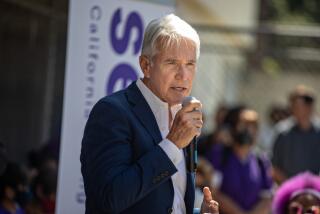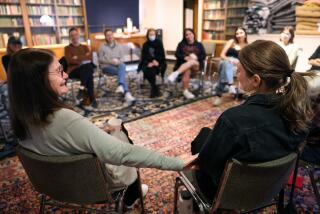Boy’s Killing Becomes a Lesson in Life, Death
- Share via
Robin Thorne held up a picture of Byron Lee Jr. for a table crowded with elementary school children.
“Here was a boy who was 14,” Thorne began.
“Who got shot 19 times,” 8-year-old Tia Steele interrupted.
“And this is going to go in the window,” said Thorne, pointing to the Day of the Dead altar the kids at the Zeitgeist Community Learning Center were building in Lee’s memory.
“What would you like for people to think about this young man?” she asked. “What do you think about it?”
Tia paused, her eyes steady.
“It wasn’t right,” she said, almost in a whisper.
Something about Byron Lee’s slaying has struck a chord in South Los Angeles, a community that is all too familiar with the horrors of gang violence. Lee was killed as he pleaded for his life, on his knees, after being shot off his bicycle.
Since the Oct. 9 shooting in a South L.A. alley, community leaders have responded with vigils and calls for peace. Such deaths are not rare, but regular, they said.
A Times analysis of Los Angeles County Coroner’s Office data shows that from 1991 to 2001, 134 people 16 or younger were slain in the LAPD’s 77th and Southeast divisions. Statistics from the past three years, in which homicide rates have declined, were not available.
Late last month, police made one arrest in connection with the slaying. Two other men are being sought.
Like many others, Romero Ross, one of the center’s student mentors, said Lee’s death especially affected him.
“I was sort of mad and hurt at the same time,” said Ross, a 16-year-old junior at Pacific Palisades High School and a South L.A. resident. “He got shot 19 times. What purpose does that serve?”
Ross brought up Lee’s killing during a “community circle” with the children, all from nearby elementary schools. At first, the conversation was reserved. Then the kids started talking. Ross, other student mentors and the adult staff guided the talk. Parents, arriving to pick up their 9- and 10-year-olds, got involved, too.
“I was surprised they knew more about this, the subject of dying, gangbanging -- these are fourth- and fifth-graders,” Ross said. So many, he added, have already been exposed to the effects of gang violence.
The kids made peace posters and hung them on the walls and in the window. Then the center’s co-founder, Jen Welsh, seeking to find some positive lesson from the tragedy, decided to integrate the discussions on Lee’s killing with a study of the Day of the Dead.
“This is a healthy opportunity for children to reconceptualize death and to understand that just because someone isn’t physically with us, that doesn’t mean they’re forgotten,” said Welsh, a USC education graduate student who opened the center in August.
Admittedly, Welsh added, “it’s an abstract concept for someone of any age group to understand, but I think it’s important.”
A roomful of rambunctious fourth- and fifth-graders might not be expected to grasp all the complexities of life, death, gang violence and a holiday that is foreign to most. But, by the sound of things each afternoon at the center, some of the lessons were getting across.
“Basically, it’s like celebrating the dead, celebrating their life,” said 10-year-old Monica Chamagua, sitting with others at a table while decorating paper skull masks.
“What’s it called again?” asked Kevin Burns, 11.
“Dia de los Muertos,” said Monica, enunciating her Spanish.
“Obviously, it’s from Mexico,” Stacy Coleman, 10, said as she applied glue and glitter to her mask.
“Other countries celebrate it, too,” Monica said, a little defensively.
“Yeah, like Africa,” Kevin said.
Many of the kids in the center’s after-school program said it was their first time celebrating the Latin American holiday that in recent years has become a tradition in Southern California.
In the days surrounding Nov. 2, homes, offices and storefronts in Latino neighborhoods across the region are alight with altars for the departed. There are also festivals and parades, art shows and lavish house parties, all based on the idea that death, a part of life, is not all tears and sadness.
The altar table will be piled this week with paper flowers and banners -- papel picado -- paper skull masks decorated with colored glue and glitter, mementos of people in their lives who have passed away, peace posters and a color photograph of Byron Lee the adults printed from the Internet.
For days, the children have worked diligently.
“This is my first time celebrating Day of the Dead,” said Stacy, while putting the finishing touches on her mask. “I think it’s cool.” When loved ones die, she added, “sometimes people are sad, and if you celebrate their lives, it will make you happy again.”
More to Read
Sign up for Essential California
The most important California stories and recommendations in your inbox every morning.
You may occasionally receive promotional content from the Los Angeles Times.













